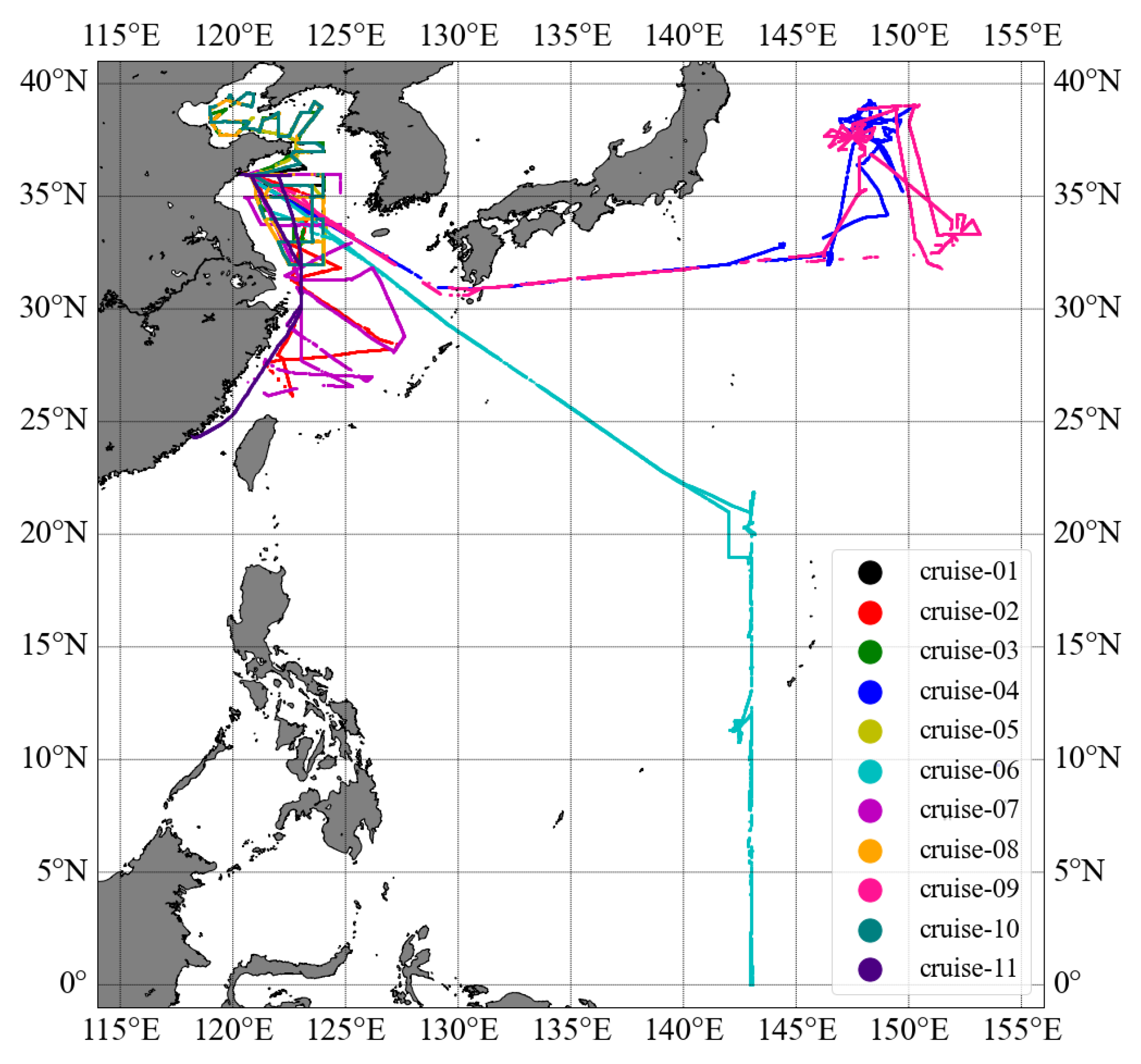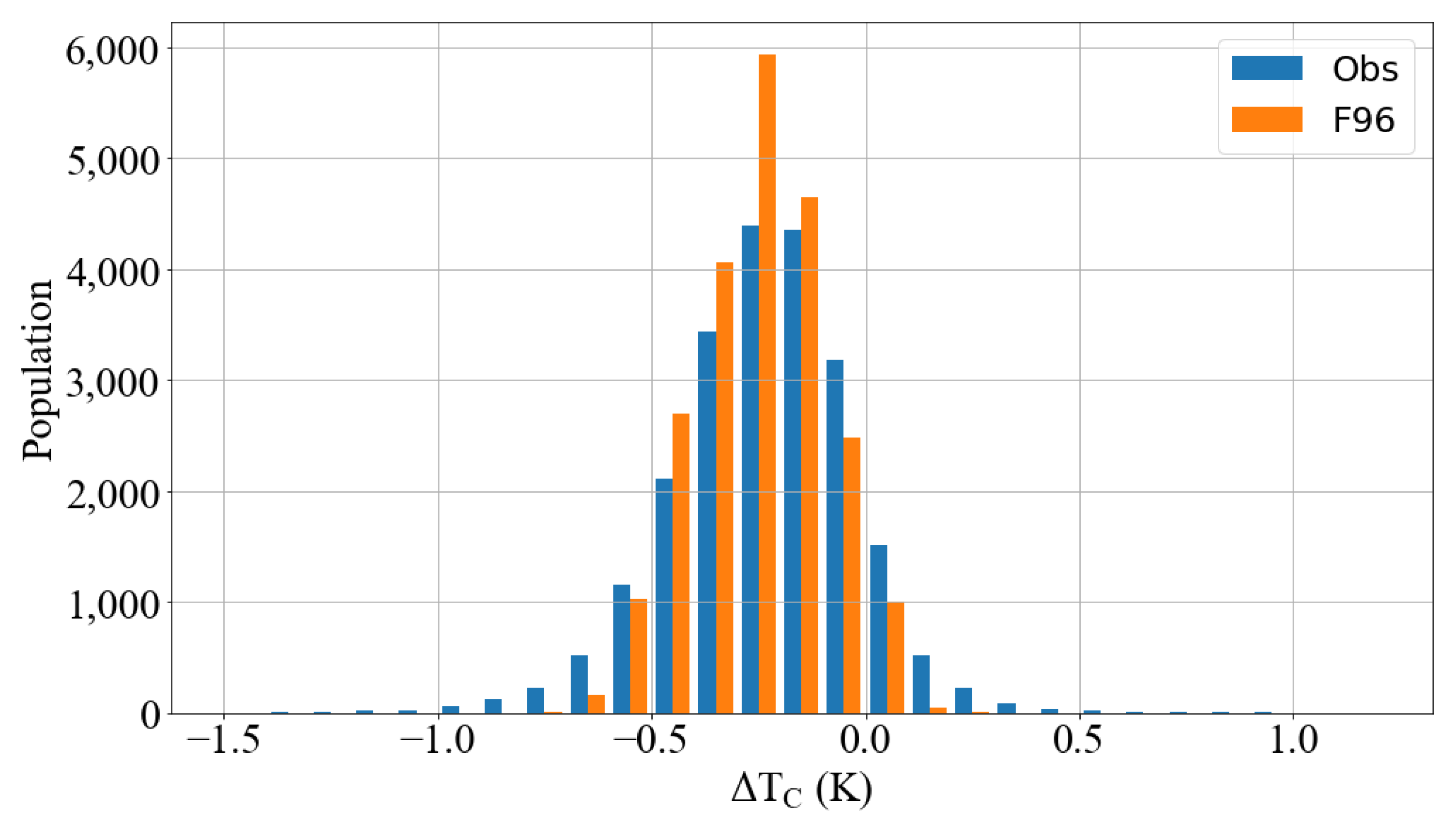Regional Study on the Oceanic Cool Skin and Diurnal Warming Effects: Observing and Modeling
Abstract
:1. Introduction
2. Materials and Methods
2.1. Shipboard Measurements
2.2. Cool Skin and Diurnal Warming Models
2.2.1. F96 Model
2.2.2. POSH Model
2.2.3. ZB05 Model
3. Results and Discussion
3.1. Cool Skin Effect
3.2. Diurnal Warming Effect
4. Conclusions
Author Contributions
Funding
Data Availability Statement
Acknowledgments
Conflicts of Interest
References
- Saunders, P.M. The temperature at the ocean-air interface. J. Atmos. Sci. 1967, 24, 269–273. [Google Scholar] [CrossRef]
- Fairall, C.W.; Bradley, E.F.; Godfrey, J.S.; Wick, G.A.; Edson, J.B.; Young, G.S. Cool-skin and warm-layer effects on sea surface temperature. J. Geophys. Res. 1996, 101, 1295–1308. [Google Scholar] [CrossRef]
- Donlon, C.J.; Minnett, P.J.; Gentemann, C.L.; Nightingale, T.; Barton, I.; Ward, B.; Murray, J. Toward Improved Validation of Satellite Sea Surface Skin Temperature Measurements for Climate Research. J. Clim. 2002, 14, 353–369. [Google Scholar] [CrossRef]
- Minnett, P.J.; Smith, M.; Ward, B. Measurements of the oceanic thermal skin effect. Deep Sea Res. Part II 2011, 58, 861–868. [Google Scholar] [CrossRef]
- Alappattu, D.P.; Wang, Q.; Yamaguchi, R.; Lind, R.J.; Reynolds, M.; Christman, A.J. Warm layer and cool skin corrections for bulk water temperature measurements for air-sea interaction studies. J. Geophys. Res. Ocean. 2017, 122, 6470–6481. [Google Scholar] [CrossRef]
- Zhang, H.F.; Beggs, H.; Ignatov, A.; Babanin, A.V. Nighttime Cool Skin Effect Observed from Infrared SST Autonomous Radiometer (ISAR) and Depth Temperatures. J. Atmos. Ocean. Technol. 2020, 37, 33–46. [Google Scholar] [CrossRef]
- Luo, B.K.; Minnett, P.J.; Szczodrak, M.; Akella, S. Regional and Seasonal Variability of the Oceanic Thermal Skin Effect. J. Geophys. Res. Ocean. 2022, 127, e2022JC018465. [Google Scholar] [CrossRef]
- Tu, C.Y.; Tsuang, B.J. Cool-skin simulation by a one-column ocean model. Geophys. Res. Lett. 2005, 32, L22602. [Google Scholar] [CrossRef] [Green Version]
- Jia, C.; Minnett, P.J.; Luo, B.K. Significant diurnal warming events observed by Saildrone at high latitudes. J. Geophys. Res. Ocean. 2023, 128, e2022JC019368. [Google Scholar] [CrossRef]
- Soloviev, A.; Lukas, R. Observation of large diurnal warming events in the near-surface layer of the western equatorial Pacific warm pool. Deep Sea Res. Part I 1997, 44, 1055–1076. [Google Scholar] [CrossRef] [Green Version]
- Ward, B. Near-surface ocean temperature. J. Geophys. Res. Ocean. 2006, 111, C02004. [Google Scholar] [CrossRef] [Green Version]
- Gentemann, C.L.; Minnett, P.J. Radiometric measurements of ocean surface thermal variability. J. Geophys. Res. Ocean. 2008, 113, C08017. [Google Scholar] [CrossRef] [Green Version]
- Price, J.F.; Weller, R.A.; Pinkel, R. Diurnal cycling: Observations and models of the upper ocean response to diurnal heating, cooling, and wind mixing. J. Geophys. Res. 1986, 91, 8411–8427. [Google Scholar] [CrossRef] [Green Version]
- Zeng, X.B.; Beljaars, A. A prognostic scheme of sea surface skin temperature for modeling and data assimilation. Geophys. Res. Lett. 2005, 32, L14605. [Google Scholar] [CrossRef] [Green Version]
- Gentemann, C.L.; Minnett, P.J.; Ward, B. Profiles of ocean surface heating (POSH): A new model of upper ocean diurnal warming. J. Geophys. Res. Ocean. 2009, 114, C07017. [Google Scholar] [CrossRef] [Green Version]
- Takaya, Y.; Bidlot, J.R.; Beljaars, A.C.M.; Janssen, P. Refinements to a prognostic scheme of skin sea surface temperature. J. Geophys. Res. Ocean. 2010, 115, C06009. [Google Scholar] [CrossRef] [Green Version]
- Akella, S.; Todling, R.; Suarez, M. Assimilation for skin SST in the NASA GEOS atmospheric data assimilation system. Q. J. R. Meteorol. Soc. 2017, 143, 1032–1046. [Google Scholar] [CrossRef] [Green Version]
- Zhang, R.W.; Zhou, F.H.; Wang, X.; Wang, D.X.; Gulev, S.K. Cool Skin Effect and its Impact on the Computation of the Latent Heat Flux in the South China Sea. J. Geophys. Res. Ocean. 2021, 126, 2020JC016498. [Google Scholar] [CrossRef]
- Donlon, C.J.; Robinson, I.S.; Reynolds, M.; Wimmer, W.; Fisher, G.; Edwards, R.; Nightingale, T.J. An infrared sea surface temperature autonomous radiometer (ISAR) for deployment aboard volunteer observing ships (VOS). J. Atmos. Ocean. Technol. 2008, 25, 93–113. [Google Scholar] [CrossRef]
- Masuda, K.; Takashima, T.; Takayama, Y. Emissivity of pure and sea waters for the model sea surface in the infrared window regions. Remote Sens. Environ. 1988, 24, 313–329. [Google Scholar] [CrossRef]
- Wu, X.; Smith, W.L. Emissivity of rough sea surface for 8–13 µm: Modeling and verification. Appl. Opt. 1997, 36, 2609–2619. [Google Scholar] [CrossRef] [PubMed]
- Niclòs, R.; Caselles, V.; Valor, E.; Coll, C.; Sanchez, J.M. A simple equation for determining sea surface emissivity in the 3–15 µm region. Int. J. Remote Sens. 2009, 30, 1603–1619. [Google Scholar] [CrossRef]
- Wimmer, W.; Robinson, I.S. The ISAR instrument uncertainty model. J. Atmos. Ocean. Technol. 2016, 33, 2415–2433. [Google Scholar] [CrossRef]
- Theocharous, E.; Fox, N.P.; Barker-Snook, I.; Niclos, R.; Santos, V.G.; Minnett, P.J.; Gottsche, F.M.; Poutier, L.; Morgan, N.; Nightingale, T.; et al. The 2016 CEOS Infrared Radiometer Comparison: Part II: Laboratory Comparison of Radiation Thermometers. J. Atmos. Ocean. Technol. 2019, 36, 1079–1092. [Google Scholar] [CrossRef] [Green Version]
- Wu, J. On the cool skin of the ocean. Bound. Layer Meteorol. 1985, 31, 203–207. [Google Scholar] [CrossRef]
- Fairall, C.W.; Bradley, E.F.; Hare, J.E.; Grachev, A.A.; Edson, J.B. Bulk parameterization of air-sea fluxes: Updates and verification for the COARE algorithm. J. Clim. 2003, 16, 571–591. [Google Scholar] [CrossRef]
- Bellenger, H.; Duvel, J.P. An Analysis of Tropical Ocean Diurnal Warm Layers. J. Clim. 2009, 22, 3629–3646. [Google Scholar] [CrossRef]












| Cruise Number | Start Date | End Date | Latitude | Longitude | |
|---|---|---|---|---|---|
| 01 | 16 Aug. 2015 | 07 Sep. 2015 | 31.99°N–39.62°N | 118.94°E–124.03°E | 294.1–301.2 |
| 02 | 17 Oct. 2015 | 04 Nov. 2015 | 26.17°N–36.1°N | 120.25°E–127.29°E | 290.7–299.7 |
| 03 | 13 Jan. 2016 | 01 Feb. 2016 | 31.98°N–39°N | 118.95°E–124.01°E | 271.1–285.1 |
| 04 | 20 Mar. 2016 | 26 Apr. 2016 | 30.9°N–39.17°N | 120.52°E–150.09°E | 275.3–297.0 |
| 05 | 27 Dec. 2016 | 17 Jan. 2017 | 31.98°N–39.62°N | 118.97°E–124.13°E | 276.2–287.7 |
| 06 | 31 Jan. 2017 | 15 Mar. 2017 | 0°–36.1°N | 120.25°E–143.17°E | 277.2–303.8 |
| 07 | 22 Mar. 2017 | 15 Apr. 2017 | 26.17°N–36.14°N | 120.26°E–127.6°E | 278.5–297.8 |
| 08 | 17 Dec. 2017 | 11 Jan. 2018 | 31.97°N–39.62°N | 118.94°E–124.02°E | 274.5–287.0 |
| 09 | 03 May. 2018 | 22 Jun. 2018 | 30.62°N–39.08N | 120.26°E–153.14°E | 283.2–300.2 |
| 10 | 20 Jul. 2018 | 10 Aug. 2018 | 31.99°N–39.62°N | 118.95°E–123.98°E | 294.3–306.5 |
| 11 | 17 Sep. 2018 | 31 Oct. 2018 | 24.32°N–36.11°N | 118.12°E–123.04°E | 288.5–300.2 |
| Mean (K) | Mid (K) | STD (K) | RSD (K) | N | |
|---|---|---|---|---|---|
| Obs | −0.23 | −0.22 | 0.22 | 0.19 | 22,085 |
| F96 | −0.25 | −0.25 | 0.15 | 0.15 | 22,085 |
| Mean (K) | Mid (K) | STD (K) | RSD (K) | N | |
|---|---|---|---|---|---|
| F96–Obs | 0.00 | −0.02 | 0.38 | 0.18 | 35,638 |
| POSH–Obs | 0.01 | −0.01 | 0.35 | 0.18 | 35,638 |
| ZB05–Obs | 0.21 | 0.10 | 0.46 | 0.29 | 35,638 |
Disclaimer/Publisher’s Note: The statements, opinions and data contained in all publications are solely those of the individual author(s) and contributor(s) and not of MDPI and/or the editor(s). MDPI and/or the editor(s) disclaim responsibility for any injury to people or property resulting from any ideas, methods, instructions or products referred to in the content. |
© 2023 by the authors. Licensee MDPI, Basel, Switzerland. This article is an open access article distributed under the terms and conditions of the Creative Commons Attribution (CC BY) license (https://creativecommons.org/licenses/by/4.0/).
Share and Cite
Liu, Z.; Yang, M.; Qu, L.; Guan, L. Regional Study on the Oceanic Cool Skin and Diurnal Warming Effects: Observing and Modeling. Remote Sens. 2023, 15, 3814. https://doi.org/10.3390/rs15153814
Liu Z, Yang M, Qu L, Guan L. Regional Study on the Oceanic Cool Skin and Diurnal Warming Effects: Observing and Modeling. Remote Sensing. 2023; 15(15):3814. https://doi.org/10.3390/rs15153814
Chicago/Turabian StyleLiu, Zhenyu, Minglun Yang, Liqin Qu, and Lei Guan. 2023. "Regional Study on the Oceanic Cool Skin and Diurnal Warming Effects: Observing and Modeling" Remote Sensing 15, no. 15: 3814. https://doi.org/10.3390/rs15153814
APA StyleLiu, Z., Yang, M., Qu, L., & Guan, L. (2023). Regional Study on the Oceanic Cool Skin and Diurnal Warming Effects: Observing and Modeling. Remote Sensing, 15(15), 3814. https://doi.org/10.3390/rs15153814






